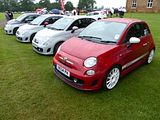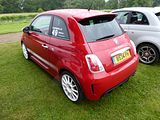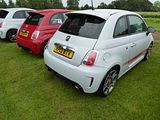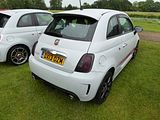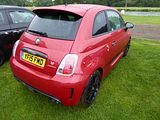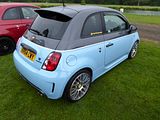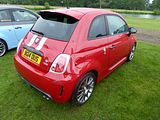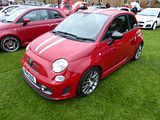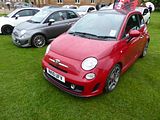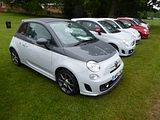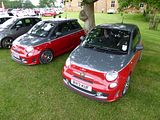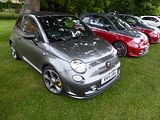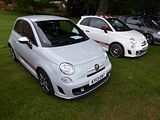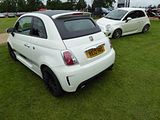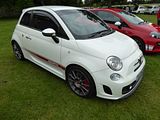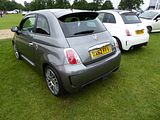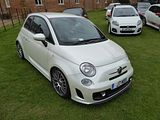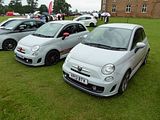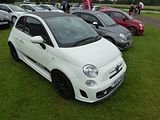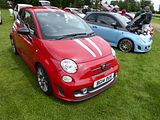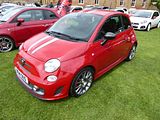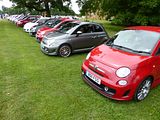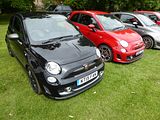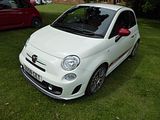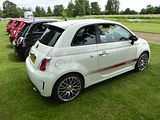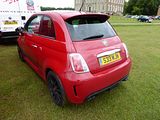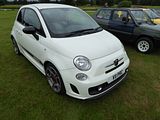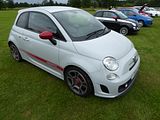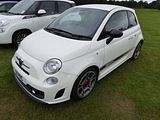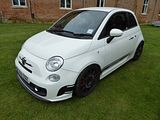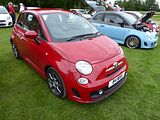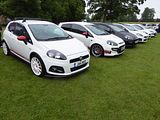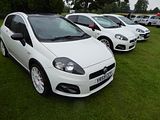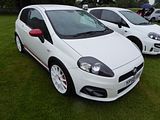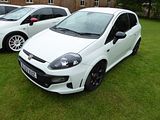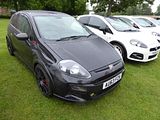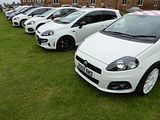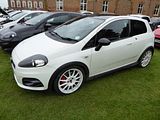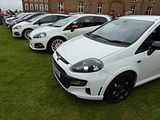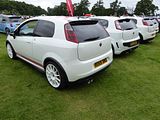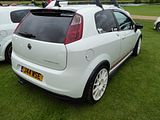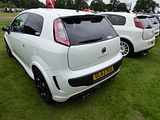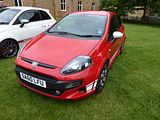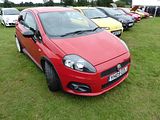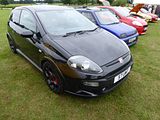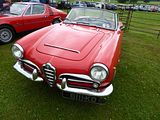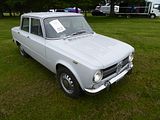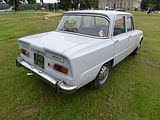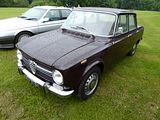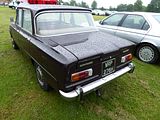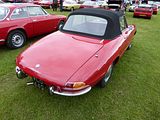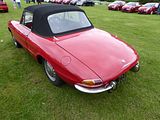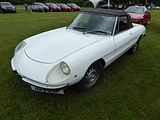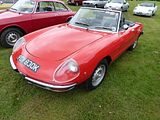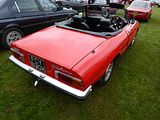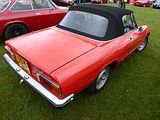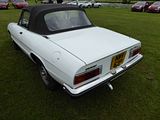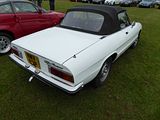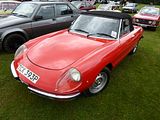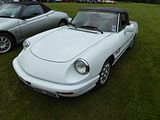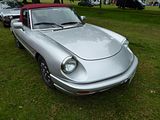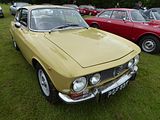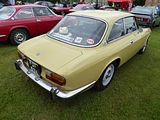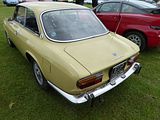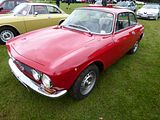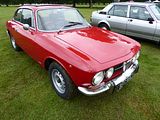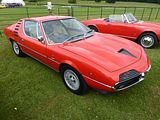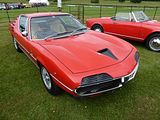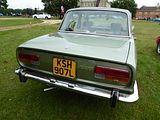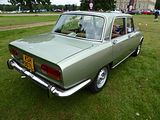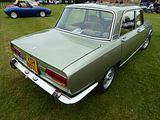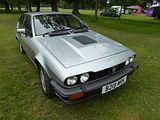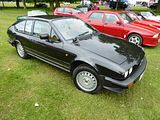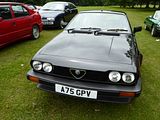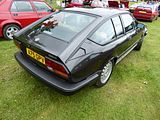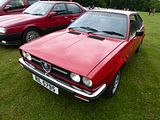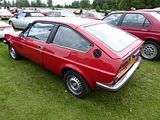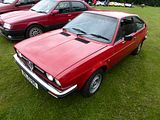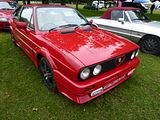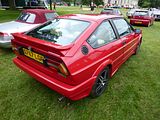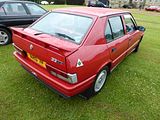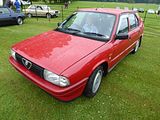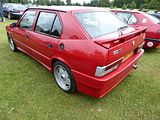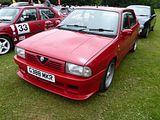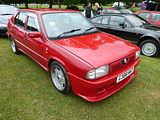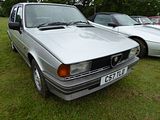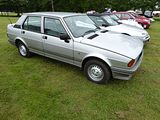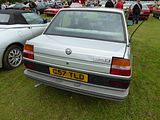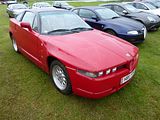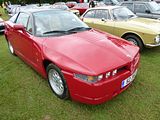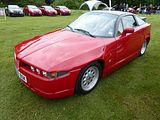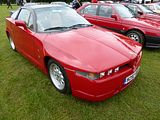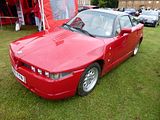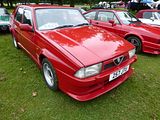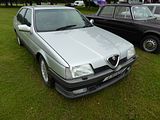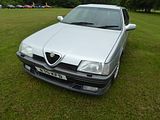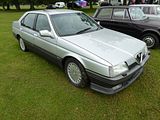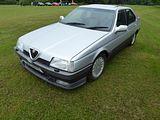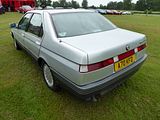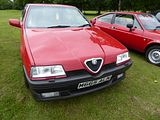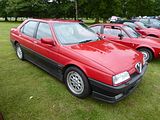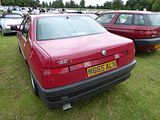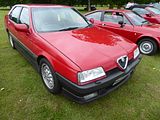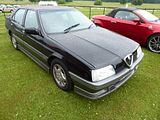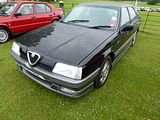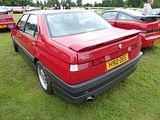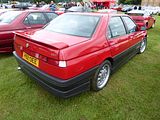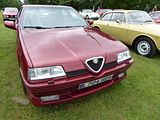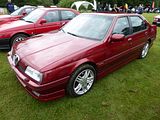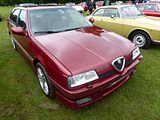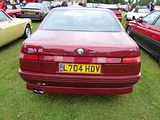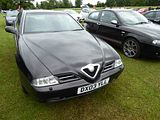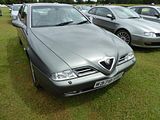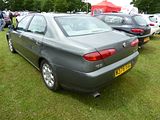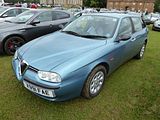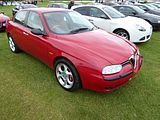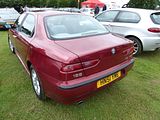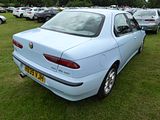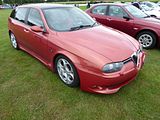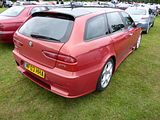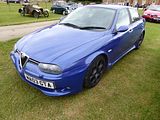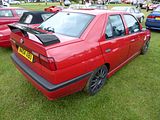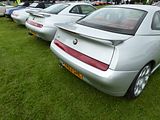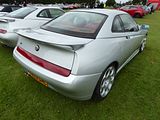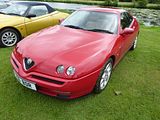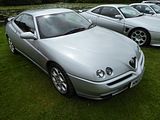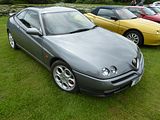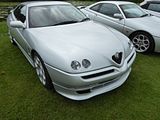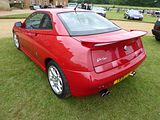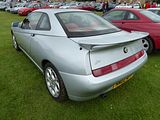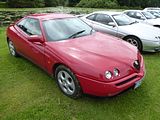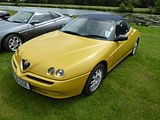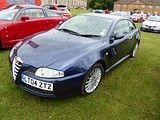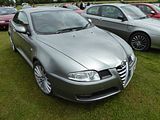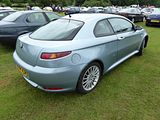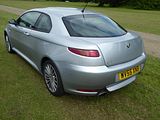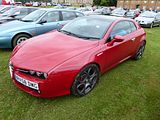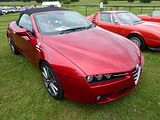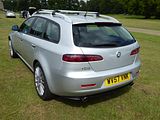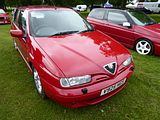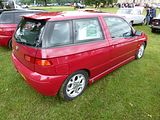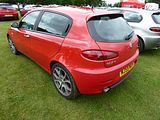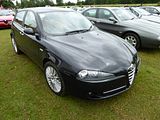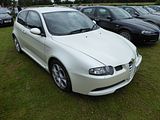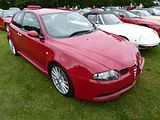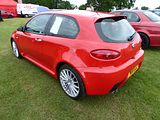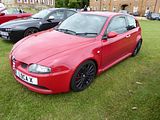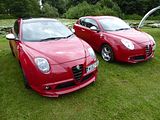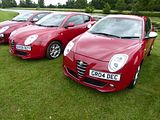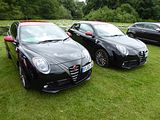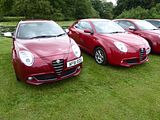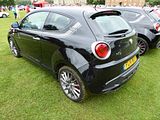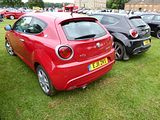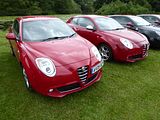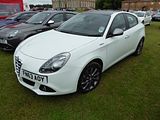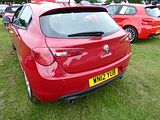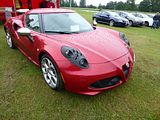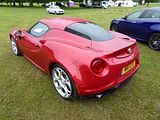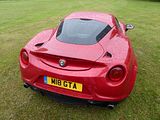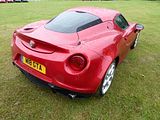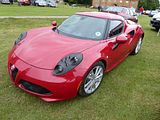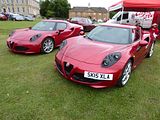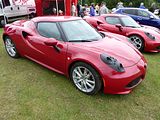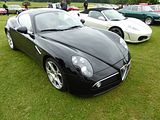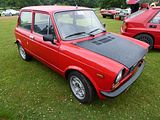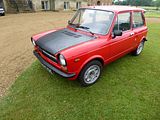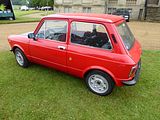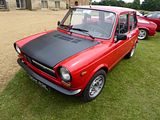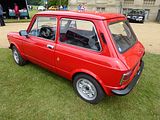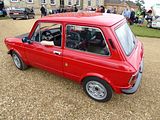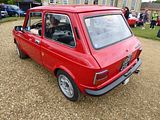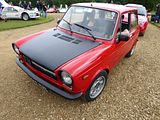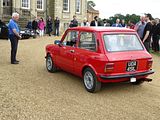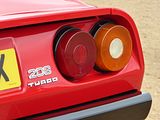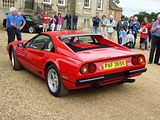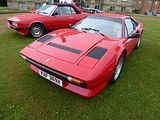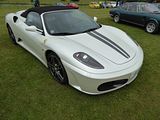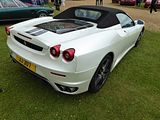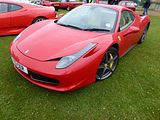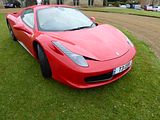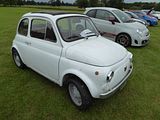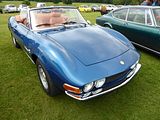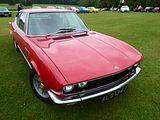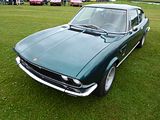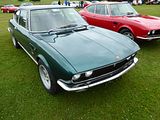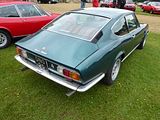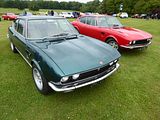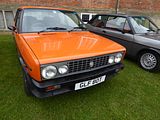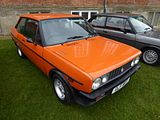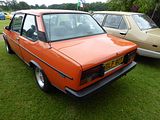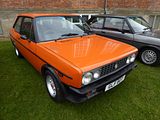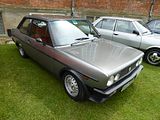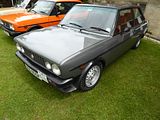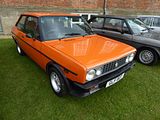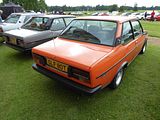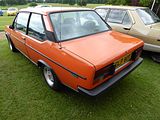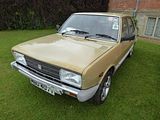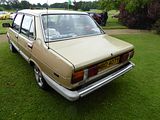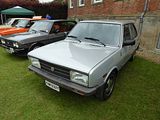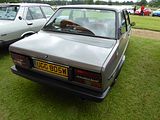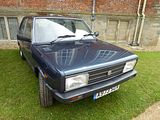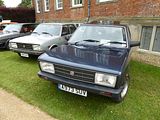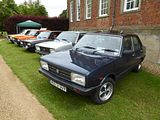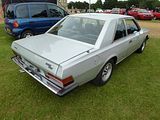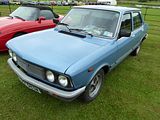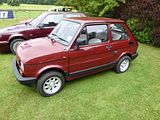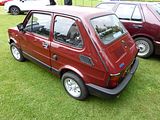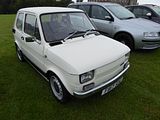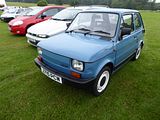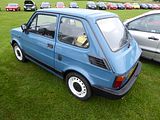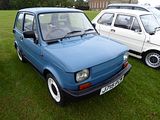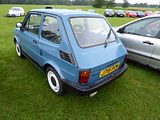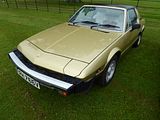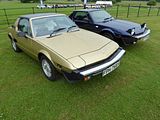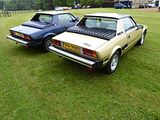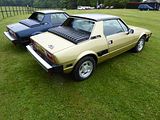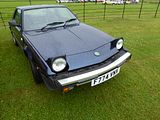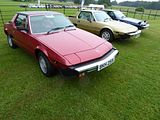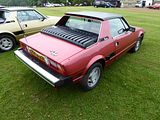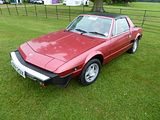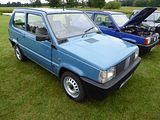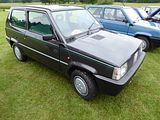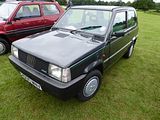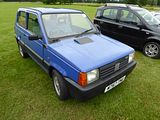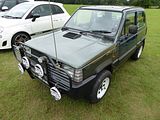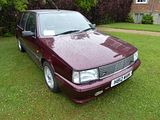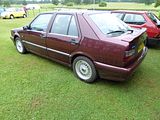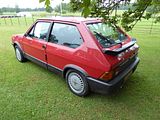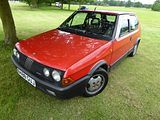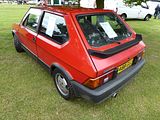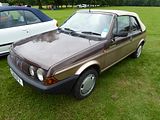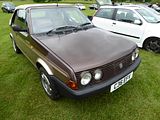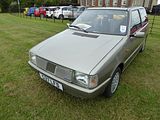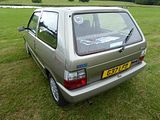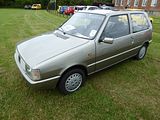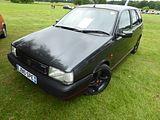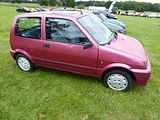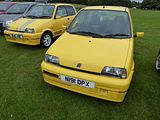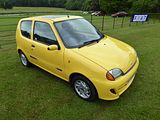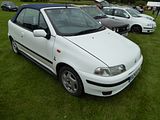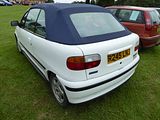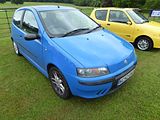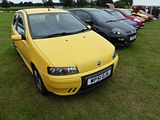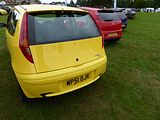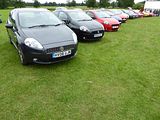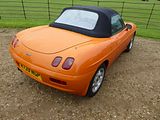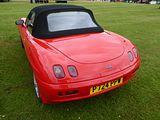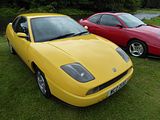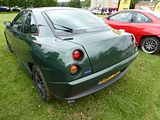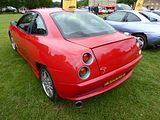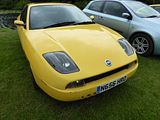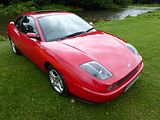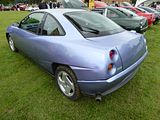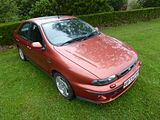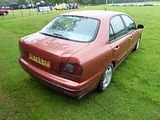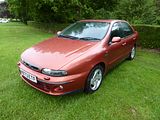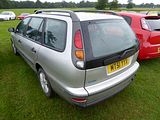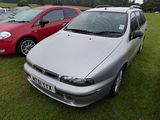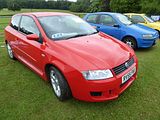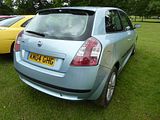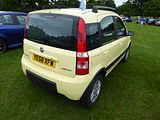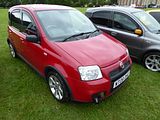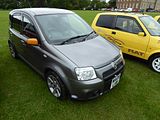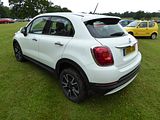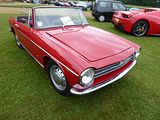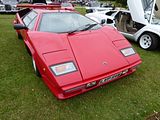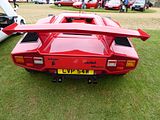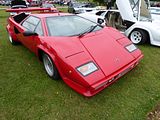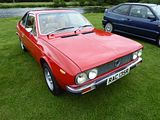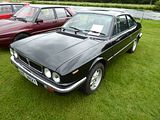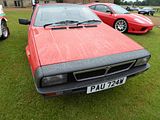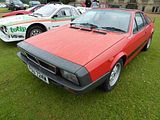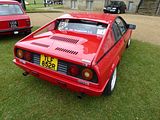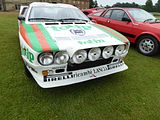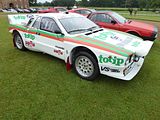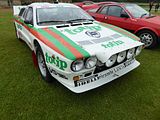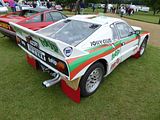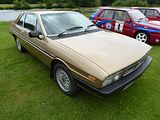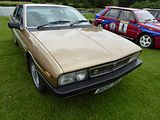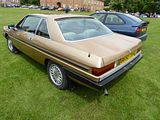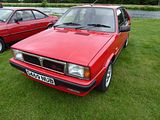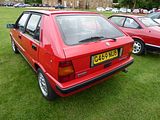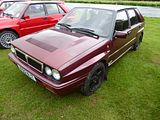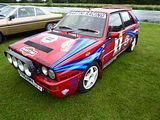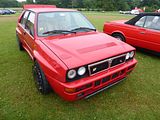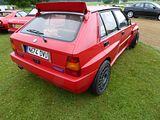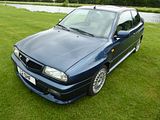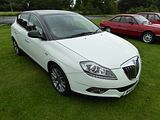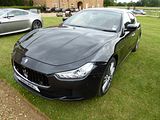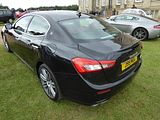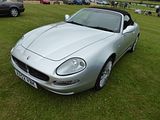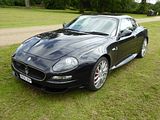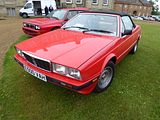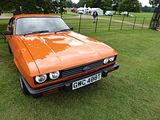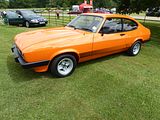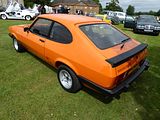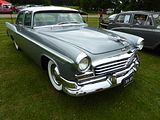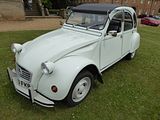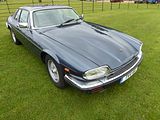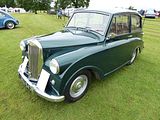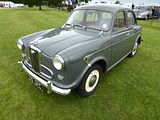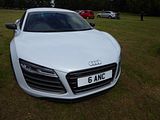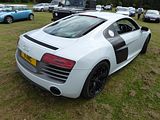The Italian car themed event held in the majestic setting of Stanford Hall, a country house located about 2 miles from the intersection of the M6 and the M1, organised by GingerBeer promotions, the events company run by Phil Ward, Editor of Auto Italia magazine may not have been running for quite as long as the gathering at Brooklands, but it has still gained quite a reputation among lovers of Italian cars as one of those “not to be missed” days out. Some years ago, the event gained a whole load more publicity when it featured in a Top Gear episode where the three stars of the show all turned up in some rather tatty Italian classics and acted in their predictably irreverent way especially when their cars were not judged to be concours winning material. Plenty of the hundreds of fabulous Italian machines which are displayed are in outstanding condition, though, so choosing a handful to win the various trophies is almost an invidious task. Of course it does mean that the judges have every excuse for scrutinising lots of glorious cars for even longer than the rest of us! I paid my first visit to Stanford Hall in 2010, a matter of days after acquiring my Abarth, and I’ve not missed the event since. In the ensuing years, the weather has been bit hit and miss, with both glorious sunshine and heavy rain (sometimes on the same day, such is the fickle nature of the British weather!). It is an unfortunate fact that as this is purely an outdoor event, a forecast of bad weather is something of a deterrent to a number of people bringing their cars, so when I saw that whereas the day before the late June 2015 event was forecast (and actually was) a sunny day but the day of the event itself was likely to be damp and windy, I feared the worst. Sure enough, the display build up was quite slow in the morning, with plenty of people hoping that the rain would pass, which indeed it did, so there was a steady rate of arrivals in late morning and early afternoon, meaning that every sight-seeing lap around the extensive venue was met with some newly arrived cars which I had not seen earlier in the day. Whilst total numbers of display cars were doubtless down a bit on previous sunny years, there was still more than plenty to see, as the photos in this report will evidence. enjoy!
ABARTH
With the same area as last year, which gave plenty of space for Abarth models, I did hope we would do a good job at filling it. I need not have worried, as soon after I arrived – and I was not the first – more and more cars turned up, so by mid morning, this was the best represented brand, out-numbering even Alfa (though that did change later in the day). I decided to arrange the cars with a long line of 500 based models around the outer perimeter and Puntos behind them, and soon the line of the smaller cars was stretching well into the distance, with an array of the different versions of the model, showing both the closed and 500C cars, plenty of 595 models in Turismo and Competizione guise, including Dave Quinn’s newly acquired 180 bhp model, in the stunning Cordolo Red that I predict is going to become very popular, and we even had one of the 695 Tributo Ferrari cars in the display. With almost all the colour options that have been available on the car, including some of the bi-colore models, this was an impressive sight.
Behind them were the Punto models. Far fewer of these were sold in the UK – less than 400 of each of the Grande Punto and Punto Evo, so it is unlikely that you will get as many of these cars as their smaller brother, but even so there was a good show, and we did eventually get a red one to complete the colour set.
ALFA ROMEO
By late morning there were more Alfa models here than any other marque, which is what you would expect, as these cars still have a tremendous following even if there are plenty of people who just don’t “get” them, and who lose no opportunity to rubbish just about every aspect of the car, as they defend their characterless Premium-box. A large number of cars also means lots of variety, and whilst there were not example of every model type from the last 50 years, there were only a few models missing, mostly the ones which are down to single digit numbers in the UK, such as the Arna and the Six, though it was slightly disappointing that there were no AlfaSud or Alfetta Berlinas and no pre-war models, perhaps scared off by the weather prospects of the day. Oldest car present was also of the prettiest, the Giulia Spider. An updated version of the Giulietta Spider, it came with a raised bonnet to accommodate the more powerful 1600cc that constituted the main difference over the 101 Series car.
First of the genuinely new 105 Series cars to hit the market, though, was the Giulia Berlina. Launched in 1962, this rather boxy looking saloon actually boasted a drag coefficient of just 0.34, which combined with the willing engines under the bonnet made it surprisingly brisk for the day. In true Alfa fashion, it did not take long before more potent engines found their way under the bonnet, not least because the car had started to carve out a career on the track as well as in stradale guise on the road. Over the next few years, a bewildering array of different versions were produced, with a mixture of 1300 and 1600cc engines, and late in the model’s life even with a diesel. A couple of Berlina models were displayed here, both of from around 1970 and both with the 1600cc engine.
The long running Spider which first appeared in 1966, and was made famous by its appearance in the Dustin Hoffman film The Graduate, is one of Alfa’s most popular classics, and you can be pretty sure that where old Italian cars are gathered, several of this model will be among their number, and so it proved here, with a mix of the different versions present, from one of the boat-tailed Series 1 cars, through a number of the Kamm-tailed Series 2 and several of the last of the line Series 4 cars.
Equally popular are the 105 series Coupe models, demand for which has caused prices to rocket in the last year or so. Whereas a nice example of a 1750GTV or 2000 GTV was available as recently as 2013 for around £15,000, now you will need to stump up nearer to £25,000. It’s not hard to see why the car is so popular: elegant Bertone styling is matched by a driving experience that brings out the best in the jewel like engines and sublime steering and handling characteristics. Many will tell you that the earliest cars, with the 1600cc engine are the sweetest of the lot, but all of them are said to be fun to drive. One day I may get to find out for myself. There was a good mix of 1750, 2000 and 1600 Junior cars here.
In 1967, Alfa presented a concept car at the Expo held in Montreal. They named if after the venue. Such was the clamour for a production version that they decided to go ahead an build a small number of them for sale. It took until 1970 for the cars to be ready. the arresting looks were preserved and the car came with a V8 engine which whilst looking and sounding great would prove to be the car’s downfall Early reliability issues were compounded by the effects of the 1973 Yom Kippur war and the general undesirability of thirsty cars. Alfa persisted, selling the last cars in 1977, though it is widely believed that these models were actually manufactured somewhat earlier than this. After years when the world’s supply of the cars all appeared to up for sale, the model has been appreciated for what it is, and values have rocketed in recent times.
To move upmarket a bit, Alfa took the Giulia, enlarged the boot, changed the front end styling and put the 1750cc engine under the bonnet, calling the car the 1750 Berlina. It was launched in 1968, and sold steadily competing against what we would now think of as premium saloons, such as the Lancia Flavia, Ford Corsair and BMW 2000. More power was created when in 1972 the engine was upgraded to a 2 litre unit. This particular car, one of the later 2000 models, is well known among Alfa circles.
The coupe version of the Alfetta premiered a couple of years after the Berlina model. Initially called GT, when Alfa slotted a more potent 2 litre engine under the bonnet to replace the 1800cc unit, the legendary GTV was resurrected. Beautiful to look at, the driver ergonomics were not quite so sound, but buyers did not really care, as they were getting not just a good looking car, but one which put a big smile on their face thanks to the sound-tack from the engine and the excellent handling that resulted from a combination of rear wheel drive and a rear mounted gearbox to give near perfect weight distribution. Things got even better when the 2.5 litre V6 engine found its way under the bonnet in 1981, even if the facelift which brought the then fashionable plastic bumpers was not quite to everyone’s taste. These days, Alfetta Berlina models are very rare, but there are still decent numbers of GTV models around, as evidenced by the fact that they were only type of Alfeftta present at this event.
The AlfaSud Sprint first appeared in 1976, a Coupe version of the by then well established ‘Sud, though it looked completely different thanks to its Giugiaro styled body. A very pretty car, it suffered a little, perhaps when the modernisation of 1983 added plastic bumpers and new detailing to it, a trend which continued with every update in the 1980s, though the addition of more power was definitely welcome, as this was a car with a chassis which begged for more than the early 1500cc engine could deliver. There were examples of both the initial design and a late model Green Cloverleaf car.
Believe it or not, but the biggest selling Alfa of all time is the 33, the 5 door hatch that was launched in 1983 as a replacement for the much-loved ‘Sud. Produced over an 11 year period, there two distinct styles, with a facelift applied in 1990 to make the front and back look more like the 164. Prior to that there had been a number of tweaks to the car, adding more power to the initial 1300 and 1500cc engines, and with various cosmetic changes also changing the looks. A couple of cars from this period were here, ARO7F, a concours winning car which always looks pristine, and Nick Grange’s much loved Cloverleaf model which he had brought up from Bristol.
There was just one example of the 116 series Giulietta, a mid-sized model which was slotted into the range between the AlfaSud and the Alfetta. Sold between 1977 and 1985, this car would have appealed to those who wanted a cut above the Cortina and Cavalier models that dominated the sales charts of the day. There are not many left on British roads now, and I am not sure that I recall seeing this particular example before.
The SZ is one of those cars which gains more fans with age. When new, in 1989, “Il Mostro” as it was nicknamed, was just too bold to find instant favour, and press reviews at the time were quite critical of the car, which was like nothing else on the market. However, this boldly styled machine has survived the passage of time quite well, and is now seen in a far more positive light.
The SZ was based on the commercially far more significant 75, another car which was not universally admired at launch, but whose appeal has increased steadily with the passage of time This car took its name from the fact that Alfa celebrated its 75th anniversary in the year the car was launched. Whilst few could doubt the appeal of the Alfa engines, there were plenty of other details that disappointed in the early cars. true to form, rather than fixing those, Alfa concentrated on making the engines even better. Now, though, as the last rear wheel drive Alfa for 30 years, the car has a strong fan base.
The 164 was Alfa’s version of the Type 4 car, a joint venture which also produced the Saab 9000, Fiat Croma and Lancia Thema. Appearing three years after the first of its half-brothers, the Alfa was, by common consent, the best looking of the quartet, thanks to its Pininfarina lines which have, in my opinion, not really been bettered since. The car drove well, and was reliable, as I can attest having owned a 2 litre Twin Spark model for 4 years and 160,000 miles back when it was new. Sadly, the survival rate of these cars is not great, so it is always a real pleasure to see a 164, especially a nice one (there are a few tatty ones out there!). There were several lovely examples here, a couple of which are doyens of Italian car events. As well as the high end Cloverleaf model which regularly wins prizes for its condition and presentation, there was a nice early 3;.0 V6 model, and Daryl Staddon had brought along his super rare Q4 model.
The 164 was followed by the 166. A long time in conception, as Alfa decided to fast track the smaller 156, this car carried forward many of the strengths of the car it replaced, but with new and still elegant body work, though I think most people – me included – thought that the revised front end that came with a mid-life facelift was an improvement on the original design with very small headlight units.
Alfa hit the proverbial bulls-eye with their 1997 156. As well as winning the Car of the Year award (not necessarily something to be proud of when you look at some of the other winners), the car was catapulted to the top of its class by the ever critical and BMW-loving press, who fell not just for its styling and engines, but pretty much all aspects of the car. I owned a V6 model for 30 months and loved mine. It’s amazing to think that it is nearly 20 years since the car was launched, and over 10 since the last was made, but the survival rate is quite decent, so there were plenty of these cars in all guises from “humble” JTD diesel to the top of the range GTA cars on show.
The 156 took over from the 155. Based on the Tipo platform, early models were something of a disappointment, but Alfa thoroughly reworked the car, applying much of what they had learned in making it a success on the track, with the model winning the 1994 BTCC championship, and with wider track, and quicker steering ratio, as well as revised engines, by 1996, the car was really rather good, though few people ever found out, as this was the time when Alfa struggled to sell 1000 cars a year in the UK. 155s are popular now among the classic car fraternity.
Those Tipo underpinnings were also used for the 916 Series GTV and Spider. Marking Alfa’s return to the sporty Coupe and open-topped market, these Pininfarina-styled beauties were first shown in 1993, but it took until 1995 to get them intro production. The 2 litre Twin Spark engine was later joined by a 3 litre V6 model, and the final cars, with a revised front end, adopted the latest units which included a 2.2 JTS engine and the enlarged “Busso” V6 at 3.2 litres. These cars are currently available very cheaply, but that position surely cannot last.
Replacement for the 916 series cars came with two model ranges, the GT and the larger and more costly Brera/Spider models. All were well represented.
This latter pair shared much of their underpinnings with the 159, Alfa’s 2006 replacement for the 156, and offered in Saloon and Sport Wagon guises. There were a few of these in the main event, though I don’t seem to have taken photos of them, finding this one in the main car park at the end of the day.
Occupying the position at the bottom of the Alfa range in the 1990s were the 145 and 146 cars. Identical from the A pillars forward, the rear ends of the two were quite different, both of them attractive in very different ways. I had a number of these as loan cars when my 164 was being serviced, and I loved them, especially the 146 Ti which I managed to keep over a weekend as it was such a riot to drive. Alfa never got that many people to try one for themselves when they were new, sadly, so few found out what they were missing. That means that there are not that many left, so it was perhaps not a surprise that there were only single examples of the 145 and 146 here.
The 147 was another “hit”. It too won Car of the Year, thanks, largely, I suspect, to its looks, which were particularly attractive, although the mid life facelift did not improve things, to my mind, with the odd slanting headlights that replaced the distinctive shapes of those on the early cars. A potent GTA model was produced only for a short time, in 2003/4, with around 300 of these being sold in the UK, so it was good to several of them at this event.
The MiTo has been on sale for several years now, and whilst the initial reaction was a bit guarded, it has established itself as a true Alfa with a following all of its own. Indeed there is now a MiTo Register, as proudly announced by the large signs that had been erected and a long line of these small Alfa models were parked up along the banks of the lake, to emphasise that an Alfa can still become something of a cult even before production ceases.
Will the same happen with the current Giuliet ta? The car certainly has looks on its side, and it is one of the better cars available in its class, even if my driving impressions concluded that some of the Alfa-ness has been removed in an effort to increase the main stream appeal. There were several examples of the car in the displays here.
Top of the current Alfa range is the 4C Competizione. Although it has been available in the UK for over a year now, they are still a rare sight on our roads. The striking looks are such that you can be pretty sure that when one is around, crowds will gather, so when I spotted that there was one of these models parked up by the large Marquee construction that the Alfa Owners Club had erected, first thing in the morning, I headed over for a good look and to grab some photos before everyone else arrived and did the same. Later in the day, a second example arrived.
The 4C’s big brother, the 8C Competizione, set some of the styling direction for the current car, and indeed the rest of the models currently produced. Hailed by many as one of the most beautiful cars of recent times, whenever one of these cars appears, it is a crowd puller, even without the benefit of the amazing noise that the car produced. Fire the engine, and you can be sure that people will appear from all over just to listen, and stare and admire…… and that is more or less what happened with this car when it made its appearance in the early afternoon.
AUTOBIANCHI
Just one Autobianchi model here, and it is a car I have seen a few times now, and which I always enjoy seeing time and again, as I have a very soft spot for, the little A112. Indeed, I would put this Abarth version in the top 3 of cars at the show that I would love to have driven away. The concours judges must have agreed with me, as it was awarded one of the prizes, and deservedly so too. It is one of the three cars that I would most like to have driven away from the event. The A112 was launched in 1969, as a sort of prelude to the commercially far more significant Fiat 127. A stylish small hatchback, it was produced until 1985, in six distinct generations, gaining power and more than its fair share of plastic adornment to try to make it look more modern over the years. The vast majority of cars were sold with low powered 45bhp 903cc engines, but the more potent ones like this one had Abarth badging and the extra power and other upgrades to go with the Scorpion badging, making them a sort of modern version of a Mini Cooper.
FERRARI
It is well known that a lot of Ferrari owners are reluctant to bring their cars out in the rain, so given the forecast and indeed the reality, I was not expecting to see many examples of the marque, and indeed there were only half a dozen Ferrari here. All were different, though, and represented a number of the V8 models from the past 35 years. Rarest car of the day, and indeed one which won a concours prize was a 208 Turbo. Looking very much like the far better known 308 GTB, this car was produced for the Italian market, and had a 2 litre turbo engine which was intended to get round the punitive tax liability in Italy that applied (and still does) to cars with more than 2000cc capacity. This car was sold new in Italy, but then found its way to Saudi Arabia, where it saw next to no use at all, as even now, more than 35 years after it was made, it has less than 3000 km on the clock. Incredible!
The evolution of the V8 Ferrari was shown by this collection of 360 Challenge Stradale, F430 Spider and current 458 Spider
FIAT
Oldest Fiat models present were examples of the classic “Nuova” 500. Dante Giacosa’s brilliant design, this cheeky little car was place in just about everyone’s hearts, with everyone saying “I want one”. Luckily a lot of them have survived, so there are plenty still available, though you won’t get a good one for a bargain price any more.
My favourite Fiat of all time, I think, the Dino came in two different versions, a Coupe and a Spider. Looking very different, they shared the same underpinnings and the Ferrari engine that was a 2 litre unit in the early cars and later upgraded to a 2.4. For a long time, these have been undervalue by the market, but that has changed in the last couple of years and prices have rocketed. Spiders are now fetching £60 – 80k, more than double their value only 2 – 3 years ago, and the Coupe, whilst nothing like as valuable, is following the same trajectory. The Coupes are lovely, and a couple of these arrived in convoy in the morning, but the Spider is the one that I really lust after. Definitely top of the “what I would like to have taken home with me”.
Final car of the “top three that I would like to have driven away” comes from among this group of 131 Mirafiori models. A rather boxy family saloon which arrived in 1974 to take the place of the 124 range, the Mirafiori was an utterly conventionally engineered car but with a lot of more brio than contemporary rivals such as the Ford Cortina, Morris Marina, Hillman Hunter, Renault R12 and Vauxhall Victor. It got even more interesting when the 1978 facelift introduced a sporting twin cam engined 1600 model, the SuperMirafiori, but it was the arrival later that year of a car which in Continental Europe was called Racing, but in deference to UK sensitivities was the Sport for the British market. Two examples of the Sport, a 2 litre twin cam that was a sports car in all but body style were on show here, and both were lovely. As I can only choose one, I would pick the bright orange one, which was a real Star of the Day for me.
The Mirafiori received a further facelift in 1981, with new bumpers and other trim details, as well as mechanical changes which saw a 1400cc engine replaced the smaller 1300cc unit. Some markets got diesel models and then a supercharged model was added to the range. It was never officially sold in the UK, but a couple of these cars have ended up here and one of them – well known in classic Fiat circles – was part of the group.
Top of the tree model in the early 1970s was the 130. Launched initially as an elegant Saloon, a Pininfarina-styled Coupe model was added to the range in 1972, and these are the ones you see more often now. An elegant car, the styling theme of which was later to form inspiration for the Rolls-Royce Camargue, these cars have not yet attracted undue attention from market speculators. It can only be a matter of time.
With the demise of the 130 range in the mid 1970s, top model that Fiat offered was the 132. Launched in 1972 as a replacement for the 125, and with a body style which distinguished it from the smaller 124 in a way that its predecessor had not done, the car came with a choice of twin cam 1600 and 1800cc engines, which gave it far more sparkle than rival products such as the Vauxhall Victor and Ford Consul. The car was facelifted in 1978, with the then fashionable plastic bumpers and a new grille being easy recognition points, and a 2 litre engine was popped under the bonnet. It is one of these cars which was shown here.
Fiat launched the 126 at the 1972 Turin Show, as a replacement for the much loved 500. It never quite achieved the same levels of popularity, even when, less than 12 months after it was released, oil prices rocketed and super-economical cars found real popularity. Maybe it was because although fuel economy was important, many customers wanted something that bit larger and not quite so basic. Car magazine, in their contentious “Good, Bad and Ugly” described the 126 as “a masochists delight”, finding it slow, noisy, uncomfortable and basic. That damning assessment was not enough to stop sales, though, and the little Fiat stayed on the market for nearly 20 years. Later models switched from an air-cooled to a water-cooled engine and versatility was improved when a hatchback was added to the rear end. There were several examples here, including a Bis, the hatch model.
Also starting its production life in the 1970s was the X1/9. Based on a concept that had been shown in 1969, the version you could buy was launched in 1972, with Fiat’s regular 1290cc engine mounted amidships behind the driver, enveloped by a Bertone built body that showed BL just what they should (and indeed could!) have done to evolve the MG sports cars, the Fiat’s most obvious market rival. It took until 1977 for the car to arrive in the UK in right hand drive form (Radbourne Racing imported a few left hand drive cars before this). Less than two years later a facelift was applied, with larger bumpers in deference of US market needs, and the 1500cc engine and a five speed gearbox were squeezed in, with a raised engine cover needed to accommodate the height of the larger powerplant. Not quite as pretty, perhaps, as the launch models, the car continued to find friends, and it remained on sale for a further 10 years, though Fiat never really developed the car any further. Indeed the last models dropped the Fiat badging altogether, with the cars sporting a Bertone logo where previously a Fiat badge had featured, as you can see if you look carefully at the front of the dark blue car in these pictures. Several of these lovely sports cars were here.
Recently retired renowned designer Giugiaro has often said that the first Panda is the design of which he is most proud. He notes that designing a small and cheap car is far harder than a costly large supercar. That first Panda stayed in production for nearly a quarter of a century, and the cars are to be seen all over Italy in quantity. Although the majority of sales were of the standard models, a series of limited edition cars as well as the Steyr Puch engineered 4WD cars were also popular and when you see Mark 1 Panda models at events like this, they tend to dominate the mix.
The Croma was Fiat’s version of the Type 4 project. Replacing the little loved Argenta, it was launched in 1985, and came with a range of different power outputs including a rather potent (for the day) 2 litre Turbo which made this a brisk as well as very roomy large family car. Like previous large Fiats, though, it did not find much commercial success in the UK, even though it was quite a good car, and survivors are rare now. I was pleased to see this very nicely presented Series 1 Turbo car.
Replacing the 128 was the Ritmo, Fiat’s first all-new design for nearly 4 years when it was launched in April 1978. A boldly styled hatchback, it took over a year before it found its way to the UK, by which time it had been decided to call it Strada. Early models came in a series of bright colours, but few of these survive, and you are more likely to come across the sporting versions which were added to the range in the 1980s. Top model was the Strada Abarth 130TC, which on release in 1984 was the most powerful hot hatch in its class. There were a couple of nice examples of the model here.
As well as the hatch versions, Fiat added a Bertone built Cabrio to the range, aimed at capitalising on the interest in open -topped versions of medium sized cars as shown by the success of the Golf and Escort Cabrio models. The Strada never sold in anything like the same numbers, so it is always quite a surprise to see one now. This car is even more unusual, as it is a very rare limited edition car called Palinuro.
By the early 1980s, Fiat appeared to be struggling, with an aging range of cars, but salvation came with the January 1983 launch of the Uno. Revealed the same week as Peugeot took the covers off their 205 supermini, a direct rival, the Fiat went on to outsell the Peugeot by some margin, and stayed in production in emerging markets long after it had given way to the Punto in Europe. Although over 8 million were made, they all seem to have disappeared, even from the roads of Italy, so seeing this one, a limited edition Breeze model produced in 1990 just before the facelifted car was revealed was particularly welcome.
The Tipo came along in 1987, taking the styling theme of the smaller and established Uno and applying it to a larger car. The rather boxy look made the car particularly roomy, and with a fully galvanised body, Fiat hoped finally to lay the spectre of rusty cars to rest. For the first few years of production, the fastest model in the range was a 1.9 Turbo Diesel, but eventually both warm and hot hatch versions arrived, with the Sedicivalvole model as shown here sitting at the top of the range. It is these cars which you typically see when – on those rare occasions – you come across a Tipo now.
With the middle of the range sorted by the Tipo and Tempra, Fiat next turned their attention to the very bottom, producing a new city car, the Cinquecento, which went on sale in 1993. Made in Poland, where the car took over from the very long running 126 model, this was an instant hit, showing that Fiat had not lost their touch when it came to building small cars. Putting the larger 1100cc engine under the bonnet to create the Sporting, an affordable little pocket rocket was a stroke of genius, as the car packed fun in a package that even the young motorist’s pocket and insurance company could handle.
The Seicento was a cautious evolution of the Cinquecento. Objectively a better car than the one it replaced, it did not quite hit the same spot in the market, which had moved on again beyond such small and minimal cars, though it did continue to sell well in some Eastern European markets long after sales ceased in the West.
The Punto is widely credited with being one of those cars which “saved Fiat”. The first models appeared in 1993, and went straight to the top of the class, combining good looks with a level of roominess not seen before in B-Segment superminis and a fun to drive nature which made them very popular wherever they were sold. Successive generations have not deviated from this formula, though with no replacement in sight for the third generation model, launched almost a decade ago, sales are far slower than they were. Puntos are simple cars to look after and cheap to own, so it is no surprise that many of those present here are the proud possession of the younger enthusiast. There was even a Cabrio version of the first model, which was popular with rental car companies in Southern Europe. Few were sold in the UK, so it was good to find a survivor among the Punto models displayed at this event.
Mazda proved with their MX5 that there was a market for a small open topped sports car again, and it was not long before a couple of rivals appeared, one of them being the Fiat Barchetta. Based on the contemporary Punto platform, this was probably the best looking of the genre, and it drove pretty well, too. Sadly, Fiat never engineered the car for right hand drive, which rather limited its appeal in the UK, and sales were limited.
Launched around the same time was the Fiat Coupe. Considered by many – me included – to be the finest design penned by controversial designer Chris Bangle, this car achieved cult status almost as soon as its short production life was over. The first cars had 16 valve and Turbo engines, but these were replaced by the 20 valve 5 cylinder unit which made the regular car rapid and the Turbo model exceedingly fast. Fiat cracked the other driving characteristics, too, and couple this with rear seats that could seat adults and a usable boot and this was a really excellent car. You don’t get quite as many at events as you used to, as now even the newest is 15 years old, and with values quite low, people are not yet convinced of spending a lot of money to keep them going, but I am sure that will change over time.
Based on the Bravo/Brava hatchback models, the saloon and estate cars, called Marea were intended to compete with the larger D Segment cars such as the Mondeo and Renault Laguna. They were simply too small to do that effectively, but those who wanted a still roomy car and who bothered to test one of them, especially if fitted with the characterful 20 valve 2 litre engine which came from the Fiat Coupe or the potent 5 cylinder diesel models found that these were rather rapid cars, and that they should not be as unfairly ignored as was the case at the time. Only a handful of them survive, so it was good to see both a Weekend (Estate) and the Saloon model.
The Stilo came in 2001, as a replacement for the Bravo/a cars, with the intent of offering much higher levels of quality than what had gone before. In so doing, a lot of the brio that had so characterised Fiats of yore was gone, and the car bombed in the market even in Italy. There is some interest now in the sharply styled three door cars, which were available with Abarth badges and a potent 2.4 litre 5 cylinder engine, as well as the distinctive Schumacher Edition cars like the one shown here.
Whilst the Stilo may have struggled, there were no such problems for the Mark 2 Panda, which came in 2004. This was more or less the perfect city car, offering lots of space, decent driving dynamics and a low price. Once again, Fiat scored a hit with the young enthusiast by creating the 100HP model, and there were lots of these present.
There was one example of the most recent addition to the range, the 500X. Designed to capitalise on the insatiable demand for “crossover” type vehicles, this car which shares much with the Jeep Renegade under the skin, was been well received by the press, and is destined to become a common sight on our roads.
INNOCENTI
As was the case in 2014, there was just one Innocenti this year. one of the very charming 950 Sports models. For those who are not familiar with these small sports cars, this pretty little machine is based on the Austin Healey Sprite, but reclothed in an elegant Ghia styled body. The cars were never officially sold in the UK, though a few of the open topped cars, and even a couple of the Fixed Head Coupe models have been imported in recent years. I think they are utterly charming.
LAMBORGHINI
If you were told that there were just 4 Lamborghini models present, which is all that were here, then you would probably guess that most of it not all would be the biggest selling Lamborghini of all time, the Gallardo. You would be quite wrong, though, as just one of the Raging Bulls was a Gallardo. Rather surprisingly, the other three were all Countach models. All of them were the 5000 models that were produced in the car’s second decade of production.
LANCIA
Early on, the only Lancia models present were those which had been singled out to park right in front of the house, but gradually a few more models did appear in the area reserved for Lancias.
Oldest cars present were a couple of the pretty Fulvia Coupe models, but both of these drove off just as I approached them, camera in hand, so they are not shown here. That means that the oldest Lancia you can see is the car that effectively replaced the Fulvia, the Beta Coupe. This was another of those really elegant Coupe models which looked completely different from the Saloon model on which it was based. Launched in 1974, the model evolved through a series of engine upgrades and minor styling changes over an 11 year production life, and the cars display here ranged from one of the first Series through some later cars.
The Beta MonteCarlo had something of a chequered career. Conceived as a Fiat, a stablemate for the X1/9, a last minute change of heart saw it gain Lancia badges at launch in March 1975. Although the car incorporated the name Beta, it had little in common with the other members of that family (apart, perhaps, from a propensity to rust). It did not take long for the car to develop a reputation for the front end to lock up and the driver to find it hard to control when braking sharply, and the problem was so acute that Lancia took the car off sale for 3 years, whilst they cleared stock of the old model and developed a solution, which amounted to a removal of the brake servo as well as other engineering modifications. The revised car appeared in 1981, but its career was short lived, sadly.
In 1980 Lancia began designing a car based on the MonteCarlo, to take over from the long running Stratos which would comply with the then new FIA Group B regulations that allowed cars to race with relatively few homologation models being built. As the project was number 037, this eventually became the name by which the car was known. Abarth, now a part of the Lancia-Fiat family, did most of the design work, even incorporating styling cues from some of its famous race cars of the 1950s and 1960s such as a double bubble roof line. The car was born from the collaboration between Pininfarina, Abarth, Dallara and the project manager, engineer Sergio Limone. Prior to its first participation in the 1982 World Rally Championship season, 200 road-going models were built to comply with Group B regulations. The car made its competition debut at the 1982 Rally Costa Smeralda in Italy, where two cars were entered but both retired due to gearbox issues. The 1982 season was plagued with retirements for the 037, but the new car did manage to achieve several wins including its first win at the Pace Rally in the UK. The 1983 season was considerably more successful for the 037: Lancia took the 1983 World Rally Championship Constructors’ title with Germany’s Walter Röhrl and Finland’s Markku Alen its principal drivers, despite serious competition from the 4WD Audi Quattro. Both drivers, however, missed the final round of the series, despite Röhrl maintaining a mathematical chance of the drivers’ title: such honours instead went to Audi’s veteran Finn, Hannu Mikkola. For the 1984 Constructors’ title defence, Lancia introduced an Evolution 2 version of the 037 with improved engine power, but this was not enough to stem the tide of 4WD competition, losing to Audi in both 1984 championships, and again to the 4WD Peugeot 205 T16 in its final works season in 1985. Indeed, Alen collected the final 037 win, and the sole one for the E2 model, on the 1984 Tour De Corse, before it was finally pensioned off in the Martini sponsored Lancia factory rally car line-up in favour of its successor, the uniquely supercharged and turbocharged 4WD Delta S4, for the season-ending RAC Rally in Great Britain.
There was just one example of the Gamma here. a late model Coupe
Everyone seems to credit Audi with popularising the compact premium hatch concept with the A3 model that they launched in 1996, but the reality is that Lancia beat them to it with the Delta by 17 years. Accoladed as Car of the Year, this Giugiaro styled 5 door hatch was a neat looking design, finished to a far higher standard than rival cars such as the Ford Escort, Opel Kadett and Renault R14. The first cars came with 1300 and 1500cc engines, but gradually more power was added, with a 1600 offered in 1982, and then a Turbo engine in 1984, However it was the 1986 Delta HF Turbo 4X4, the first of what became the Integrale cars that really put the Delta on everyone’s radar. Intended initially as a homologation special so that Lancia had a car that they could use on rallies in the post Group B era, this was a surprise hit, and demand was strong for the next 7 years. Nowadays, Integrale models are quite a common sight at gatherings of Italian or classic cars, whereas the regular models are far rarer. It was nice to see examples of both here.
A second generation Delta was launched in 1993. By this time, Lancia’s reputation had not recovered from the battering it took over the Rusty Beta saga exposed by tv consumer program “That’s Life” so the company decided not to sell it in the UK, which was probably wise, as whilst the car was worthy enough, the marketplace was crowded and with no halo-style Integrale model, it would doubtless have struggled to make its mark. A small number of left hand drive cars have found their way to the UK since then.
After something of a gap, a third generation car appeared, looking, well, rather odd. With Lancia long since out of the UK market, it gained Chrysler badges and came here for a short market sojourn, during which I singularly failed to appeal to many people, but a few were sold and one of them was here.
The Y10, launched in 1985, was sold as an Autobianchi in some markets, but for the UK, where that brand had never been offered, it came with Lancia badging. An upmarket small car, again, long before the Audi A1 popularised the genre, this city car came with a range of engines from 45 bhp to a potent Turbo (complete with torque steer!). This is one of the Phase 2 cars with a revised grille being the point of identification.
MASERATI
In previous years, the Maserati Owners club used to hold their AGM the evening before this event, which meant that you could end up with over 100 classic Maserati models on display here. When the event was moved to later in June, it now comes a couple of weeks after that AGM, and so you don’t get anything like the same number of Maserati models, sadly. Indeed, there were only a handful here, and none were more than a few years old. Newest was the current Ghibli saloon, an executive rival to the ubiquitous 5 Series and E Class.
It was joined by a previous generation Quattroporte and a trio of 3200/4200 generation cars in both Coupe and Spider guises.
Oldest Maserati present was a Cabrio version of the long-lived BiTurbo family. Produced by Zagato, these cars looked good, especially with the roof down, though the sad reality is that the early ones were not that special to drive and were somewhat unreliable. Values are still low, so survival rates are not great, as restoring one is not (currently) cost effective. This was a nice example.
NON ITALIAN CARS
A couple of years ago, the event was changed from being solely for Italian cars, and the title incorporated the phrase “Summertime Classics” as a result, but the reality is that only a handful of non Italian machines come along as part of the display, and that was as true this year as it was in 2014 and 2013. One of the most admired cars in this category was a Signal Orange Mark 3 Ford Capri 3.0S. I had in fact seen this car as I was en route to the event, being trailered along withe M6 and it did not occur to me that I would find it here later in the day. This 1979 car has still only covered around 4500 miles. It spent many years in a showroom, not being used, and when the current owner acquired it, only 2500 miles were on the clock. He has subjected it to a fastidious re-commissioning and restoration so it is probably now better than it was when new.
A deserved concours winner was this fabulous 1956 Chrysler New Yorker.
More familiar to European eyes were two very different classics, a Citroen 2CV and a Jaguar XJS
Although only Triumph Mayflower is shown here, there were actually two of them present. The Mayflower was a small car that adopted the same razor edged styling as the larger Renown/1800. It was positioned as more upmarket than the similarly sized Austin, Morris and Ford cars of the period, and that was not really a winning sales strategy in the austerity years of 1949 to 1953, so no surprise that its successor was cheaper in every respect, and that it adopted the Standard badging. Despite its upmarket ambitions, the cars were not particularly well built and so few have survived.
The Wolseley 1500, a sister car to the Riley One Point Five, was originally conceived to replace the Morris Minor. Slightly larger than the Morris, BMC’s plans changed and this car, launched in 1957 ended up being outlived by the Minor by some years.
This Audi R8 was in the event car park, at the other end of the venue from the display cars.
Despite the rather unpromising start to the day, this turned into an excellent event. It is not as big as Brooklands, and despite the Concours element to the proceedings, it is all rather laid back, which means that there is ample time to talk to people as well as to see lots of lovely cars. It is one of those unmissable ones which always finds an inked-in place in my diary as soon as the date is announced. It will in 2016 as well.


